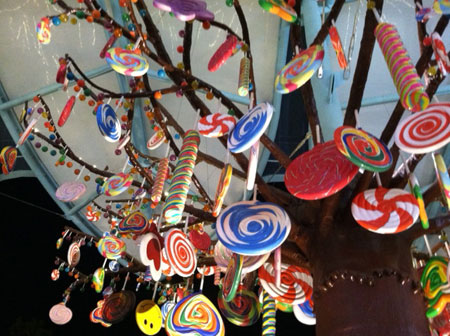Essay by Martha Nichols
How I Fell for an Unlikely Place
Sweat.
On a Saturday morning in February, sweat was about the only thing I could think of, climbing to the summit of Bukit Timah Nature Reserve.
Excuse me, perspiration—except, no, I mean sweat, drenching my T-shirt, dripping down my neck, steaming up my glasses so badly that I had to take them off.
At one point, my ten-year-old son studied me as we chugged more water. “I can see the sweat on your face!” he cried in mock horror.
This led to a string of giggled nicknames for me as we slogged on. “Saltskin” was my favorite, “Easy Sweat” a distant second.
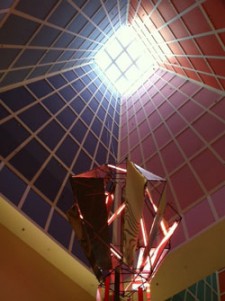 In the spring of 2012, when my husband was a visiting scholar at a university in Singapore, I came prepared to sweat. My suitcase was stuffed with tank tops and T-shirts. We’d landed just north of the Equator, at the tip of the Malay Peninsula, where temperatures average 88 degrees Fahrenheit.
In the spring of 2012, when my husband was a visiting scholar at a university in Singapore, I came prepared to sweat. My suitcase was stuffed with tank tops and T-shirts. We’d landed just north of the Equator, at the tip of the Malay Peninsula, where temperatures average 88 degrees Fahrenheit.
Yet, it’s shockingly easy to avoid sweating in Singapore—my first clue that all was not what it seemed there.
Even if you can’t afford air-conditioning in your apartment, you can escape to a refrigerated cafe or mall. The subway is air-conditioned; buses are air-conditioned. Or you can choose to hike in a protected area of rainforest.
In Singapore, sweating has become a lifestyle option.
This “little red dot” of a country has only been an independent entity since 1965, but its skyscrapers point at the clouds as if to order them around. Its city planners tell a rousing story of rapid advancement at the URA Centre, where a theater-in-the-round displays airbrushed scenes of modern Singapore with titles like we scamper, we luxuriate, and—yes—we sweat. “URA” stands for Urban Redevelopment Authority, just one of many government acronyms that euphemistically bedeck the sleek new buildings.
In Singapore, you don’t have to look far to find the earnestly bombastic. But soon I craved the Red Dot’s optimism and oxymoronic goofiness. I didn’t expect to like it, let alone to fall in love—until I did, as if I were some tough-talking manga girl who melts at a flock of neon-pink hearts.
• • •
The Bukit Timah Reserve is a national park in the middle of the island that “contains more species of trees than the entire North American continent,” proclaims at least one government agency. To which I could respond, like a local bantering in Singlish, “Why you so kiasu?”
For decades, kiasu has been derided and embraced as the national trait of Singapore. To be kiasu is to push your way ahead, to grab anything you can for yourself, to be the biggest and best in all things. Kiasu amounts to chest-thumping on this SMALL ISLAND with BIG PLANS (another motif portrayed in giant block letters at the URA Centre), and the attitude is by turns hilarious and misleading.
Bukit Timah, for instance, also includes Singapore’s “highest summit,” a fact that official literature can’t seem to help citing. But at 537 feet, this is a hill rather than a towering mountain peak. Bukit Timah is lowland jungle: lush, viney, challenging.
Still, my family of three had been been looking forward to visiting the reserve, hoping to spy rare birds, flying squirrels, and wild orchids. I’d suggested we get out early that Saturday in February, and we did arrive by taxi around 9:30 a.m.
But by that time, the birds were moving dots way at the tops of very tall trees. Except for a troop of macaque monkeys cadging food in the parking lot, the only animals we saw were humans. Some stretches of the main trail had all the hustle of one of the glamorous shopping malls on Orchard Road.
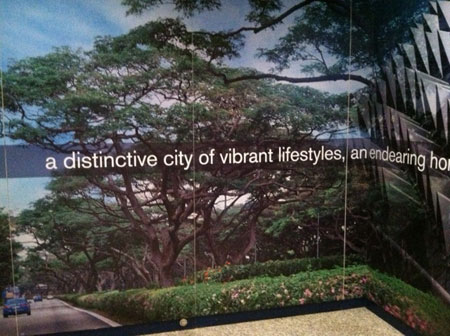 Our band of hikers included my bespectacled husband, who towered over almost every nonwhite person on the trail; my high-octane son, a Vietnamese adoptee, whose slender body was at odds with his long hair and loud American voice; and me, a white woman sweating in a T-shirt that read “Footprints for Change.”
Our band of hikers included my bespectacled husband, who towered over almost every nonwhite person on the trail; my high-octane son, a Vietnamese adoptee, whose slender body was at odds with his long hair and loud American voice; and me, a white woman sweating in a T-shirt that read “Footprints for Change.”
My son insisted on hiking in flip-flops. Within half an hour, he’d tripped and bruised his knees. His choice of footwear, selected for its chic blue-and-yellow styling from a Chinatown stall, mimicked the average Singaporean on a city street—but not the diligent Bukit Timah trekkers, many of whom had on spic-and-span boots or running shoes.
I was the sloppiest hiker we encountered. Hanks of soaked hair kept sliding out of my scünci-bound ponytail. I avoided every passing glance.
“I don’t sweat,” my son said.
“Say what?” I huffed. “You’re sweating right now.”
“I’m crying through my skin.”
There was not a breath of breeze. We were walking through a rain cloud, with every drop precipitating on my face. Other hikers had at least brought washcloths to wipe their necks.
I got to witness kiasu in action. On one steep stretch of stair-stepped trail, a solid line of us panted forward, as if we were in a race for an Olympic medal. We could have been doing time at the health club.
At the summit, we reached a large, roofed “hut” packed with uniformed teenage hikers. They chattered and passed around candy bars, ignoring signs about marauding monkeys. It reeked of citronella and youthful hubris.
There were several ugly radio towers on the summit, too, fenced in with barbed wire. The standard “Protected Place” sign warned everyone away in four languages. Much to my ten-year-old boy’s delight, it featured silhouettes of a soldier pointing a gun at a civilian who had his hands up.
• • •
The contrasts in Singapore flummoxed me: Muslim headscarves worn with skimpy blouses and tight jeans; the mating dance of wild cranes evoked in an animatronic light show. Bits of jungle are preserved, but they’re often mixed with “features” like mahogany boardwalks through the tree tops—or a cable car from Mount Faber to the theme parks of Sentosa Island.
During one outing along the Southern Ridges Trail, a week after our Bukit Timah hike, my son and I encountered a troop of six monkeys on a deserted boardwalk. My boy gleefully skipped toward the biggest male with his camera. Then the smaller monkeys hopped and hissed around us, grabbing for his legs. I fended off the feistiest with an open umbrella, like a neurotic Mary Poppins.
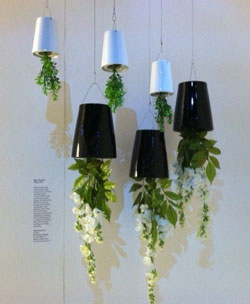 Not exactly the Discovery Channel. Except that scene seemed far more Singaporean than the well-marked trails of Bukit Timah.
Not exactly the Discovery Channel. Except that scene seemed far more Singaporean than the well-marked trails of Bukit Timah.
There I was, with my leopard-spotted synthetic umbrella. There was the monkey, who seemed as annoyed as a kiasu old man elbowing aside a clueless ang moh (white person). There was my excited son, who speculated that the monkey took off because it thought the umbrella was a jaguar.
“Watch out for the monkeys!” he shouted as we ran past a middle-aged guy walking his bulldog on the boardwalk.
The guy just nodded wearily, proceeding with his portly guard dog.
Our breakneck retreat, under ink-black clouds and backed by booming thunder, did get my son and me to the nearest MRT subway station before the rain gushed down. Maybe the monkeys were supposed to chase us away, I joked with him. Maybe our guardian spirits were watching over us.
Maybe all the careful planning in the world can’t compensate for chaos in the shadows, but it’s comforting to think that it can.
• • •
I did feel guilty sometimes, basking in the artificially cooled cafes and rest areas of Jurong Bird Park, the zoo, the Night Safari—all those “natural attractions” that one Chinese colleague of my husband’s wryly noted are “just like Singapore. The animals do exactly what you want them to.”
But not that guilty. The midday heat took on solid form, a lump of flesh at body temperature. It was like shoving my way through a gelatinous mass.
My son and I would fling ourselves into an air-conditioned mall, panting and flushed, until the refrigerated air had us running outside again. After watching a movie in one meat-locker of a theater, we stumbled to the bathroom to run our stiff fingers under hot water. We got used to these temperature extremes, but they also did me in. They were a sucker punch to the body, especially my hopped-up, pale-skinned, nervous-bird body.
In the tropics, humidity hovers at 75 percent or more. Still, it took me months to accept that I wasn’t a contestant on Survivor or my twenty-year-old backpacking self. Instead, I collapsed into corpse-like sleep after a two-mile hike. The moist heat turned my thoughts gelatinous as well, like egg whites solidifying in a skillet.
• • •
Singapore was easy for me in the expected ways: English is the national language, tap water is safe to drink, I didn’t live in fear of what would happen to my mischievous little boy if I lost him in a crowd.
Yet, I struggled at first. Within weeks of our arrival, I learned that my mother in California needed surgery. I wanted to pack my bags right then. I loved spending time with my son, whom I was homeschooling, but he could talk me into a stupor, especially as my mood began to deflate.
One of our short-term apartments abutted a major construction site, forcing us to move to another neighborhood. I hate this place, I remember thinking.
If anything seemed truly wild on the island, it was the constant rise and fall of big buildings. Pits hollowed out by roaring machines were everywhere. Yellow cranes tracked and clanked across the sky, slow-moving predators. Rebar spikes poked out of orange mud like meat-stripped bones.
My internal landscape was never quiet, either. It was both a jungle that needed controlling and a new country with an identity in flux: naive, pushy, strange. Both my parents had succumbed to dementia, and I thought of their inner worlds unraveling, their foundations scooped out like soft earth.
Who am I? It’s the question many Singaporeans pose, whether they’re critics or boosters. And who are we? As a nation, a culture, a soul?
I asked the same questions of myself, navigating everything I couldn’t predict.
• • •
One cab driver joked with us about the “insta-trees” of Singapore. Early on, I dismissed the trees that had been hacked into decorative stands along the roads, as if they were a fringe around a balding scalp. One of the most natural vistas I came across was on the runway at Changi Airport: a band of green on the horizon, unbroken by buildings or the loops of subway tracks.
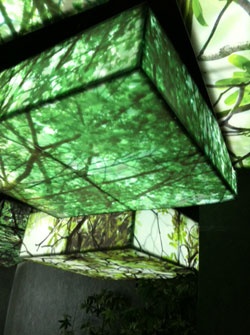 In Singapore, nature has been reimagined in countless ways, in shopping mall art, in skyscraper gardens. Trees, central to traditional Asian aesthetics, are not only living things; they’re symbols of beauty, of spirit, of all that must be left behind.
In Singapore, nature has been reimagined in countless ways, in shopping mall art, in skyscraper gardens. Trees, central to traditional Asian aesthetics, are not only living things; they’re symbols of beauty, of spirit, of all that must be left behind.
But despite myself, I was increasingly drawn to the city’s artificial spectacles—to the Marina Barrage, of all places, a paean to the water-use and infrastructure-development plans of the PUB (Public Utilities Board).
Under the blazing sun, we walked across the barrage, which dams the Marina Channel and holds back the sea. In my case, I sprinted across, sweaty after five minutes and fighting the white glare. I spent much more time in the Sustainable Singapore Gallery, viewing a model of the barrage and its floodgates, soothed by the piped-in sounds of trickling water.
I was happy to be inside with the diffuse lighting, air conditioning, and canned history. The PUB promises that the barrage will bring a “Whole New Lifestyle” to Singaporeans. An image of a boy flying a kite, superimposed over public housing, includes this text:
Singapore—with more Eco-friendly townships, industries and buildings coming.
“With park connectors and waterways weaving A Tapestry of Green and Blue throughout the City.
The highlighted phrases resemble so many official exhortations and acronyms, the Orwellian messaging that Singapore is famous for. But in that peaceful gallery, I had to admit that human beings could use a little direction.
Value Life. Act Responsibly. Every day,I contemplated this message from my local MRT platform. At first, it seemed no more than quaint. But eventually, I loved such explicit hopes for humanity.
One minute I was laughing, comparing Singapore to Thneedville in the latest movie version of The Lorax, in which the citizens of that fictional town accept state-of-the-art “trees” as replacements for real ones. The next, I was snapping iPhone pictures of the lollipop tree outside Candylicious on Sentosa Island, thinking, what the heck? Why not?
Sweat.
You can smell it on the diligent weekend hikers and in the effort involved in constructing a new world.
About two-thirds into our Bukit Timah hike, I’d adjusted to my Saltskin existence. Once you’re drenched, you might as well give in.
It wasn’t the solitary communing with a wild landscape I’d hoped for, but by the time I reached the Jungle Hut halfway up one hill, I was in an altered state. I felt like a shimmering vision in red, although I imagined achieving a new state of being, turning into a blue column of light.
A column of light doesn’t sweat.
In the end, it was just me, splashing cold water on my face in the restroom at the visitor center. I wondered if the experience was meant to be the equivalent of a multimedia display at the Marina Barrage. For a designated chunk of time, you sweat; your muscles stretch. You taste nature in the raw and feel good about the effort.
I was glad I’d hiked Bukit Timah, but it’s not a place my family returned to, and only now do I realize why. The wilderness I wanted to explore lies elsewhere in Singapore, in its evolving national identity and constructed spaces.
It’s in all the things that don’t make sense at first but ultimately do—like the bats I loved to watch swirl around a neighborhood tree at sunset, shadowed by two huge subway tracks and their pylons.
It’s in me, contending with the losses of middle age, with the certain knowledge that chaos awaits. But oh, how glorious to grab for the bananas while you can, to plan the perfect world, to realize that this is what everyone wants and that the mix of failure and longing can be beautiful.
“Hey, Easy Sweat!” my son sang out.
We were walking across the Bukit Timah parking lot, where several old men swabbed off their bare chests with hand towels. The monkeys were gone.
“No, I’m Saltskin,” I said.
“I’d like to live here,” my son said.
I looked at him, scuffing along the grass verge toward the main road in his flip-flops. His head was down, his expression hidden by glossy black hair. He had sounded offhand; maybe he’d been thinking about Ion Orchard, his favorite shopping mall, with its swooping escalators and complimentary Mentos at the information kiosks. Yet, I think he meant it.
Then we boarded a bus back downtown in which the air conditioning was so arctic I found myself shivering.
Who would have thought Saltskin would be guzzling a bowl of hot noodle soup an hour after leaving the rainforest? But that’s what Saltskin did, in a food court near the Dhoby Ghaut MRT. It brought the warmth right back into my heart.
I ♥ S’Pore
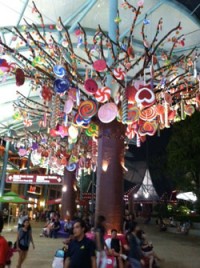 “You went to get a handicapped sticker just to chope a parking space? How kiasu can you get?”—The Coxford Singlish Dictionary
“You went to get a handicapped sticker just to chope a parking space? How kiasu can you get?”—The Coxford Singlish Dictionary
“We strive to create a vibrant and sustainable city of distinction.”—the URA
- “Singapore Facts and Figures,” Singapore Economic Development Board.
- “To Make Singapore a Great City to Live, Work, and Play In,” URA.
- “Kiasu” in The Coxford Singlish Dictionary, TalkingCock.com (“Exercising Free Speech in Singapore Since 2000″).
- “Bukit Timah Nature Reserve,” National Parks (“Let’s Make Singapore Our Garden”), Singapore Government.
- “Please Don’t Feed the Monkeys,” Wild Singapore (website run by Ria Tan). Quote: “As humans try to protect themselves or their children by hitting out at the monkey, the monkey will in turn also retaliate. An ugly incident may develop.”
- “Welcome to Marina Barrage” (“Singapore’s Latest Downtown Icon”), PUB.
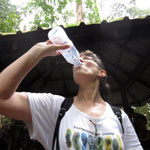 Martha Nichols is Editor in Chief of Talking Writing.
Martha Nichols is Editor in Chief of Talking Writing.
Martha still longs for Singapore but doesn’t miss sweating. At all. This photo of her slugging down water in Bukit Timah was taken by her son.

